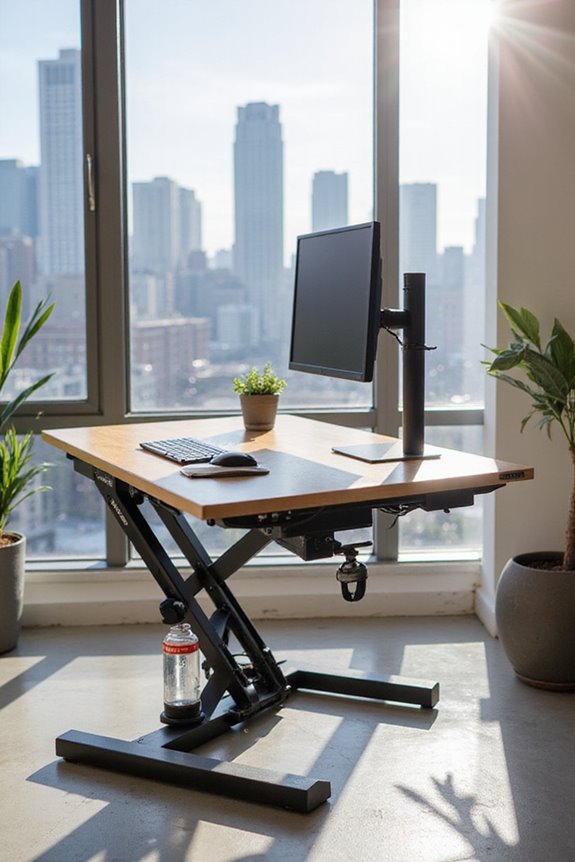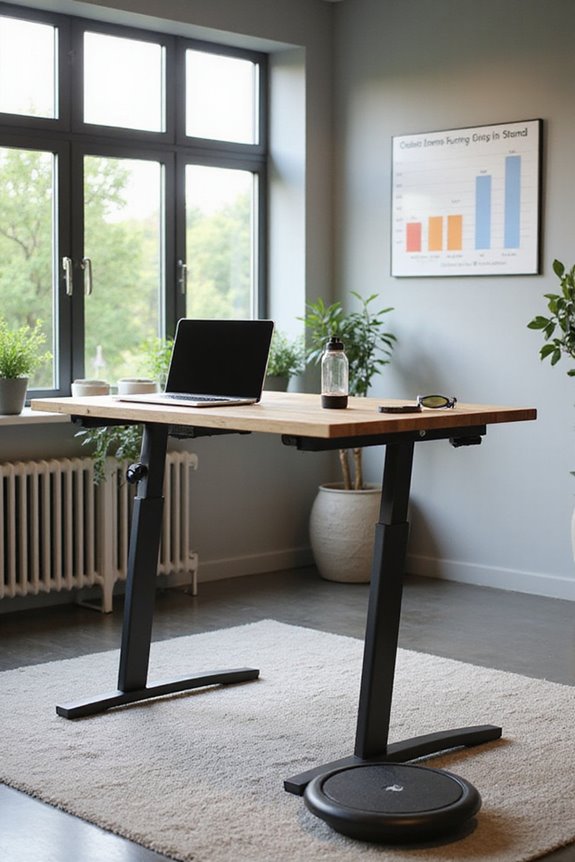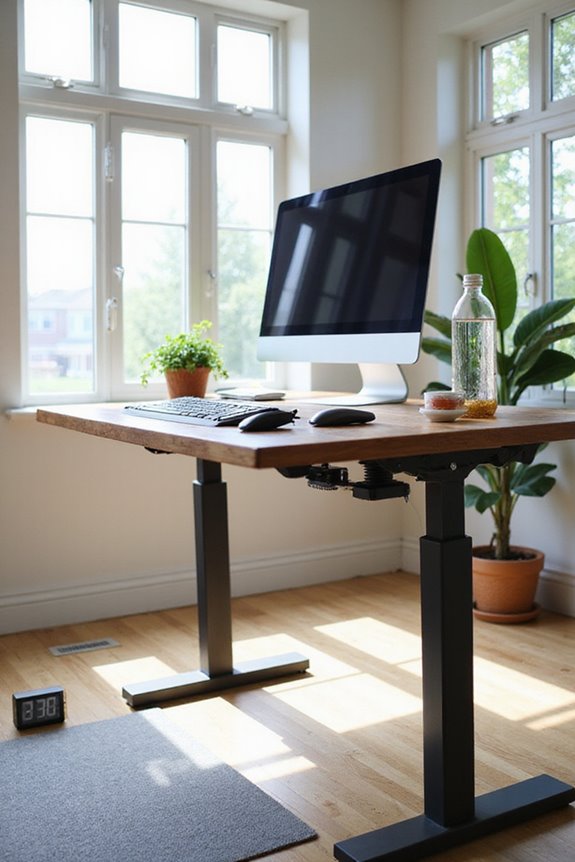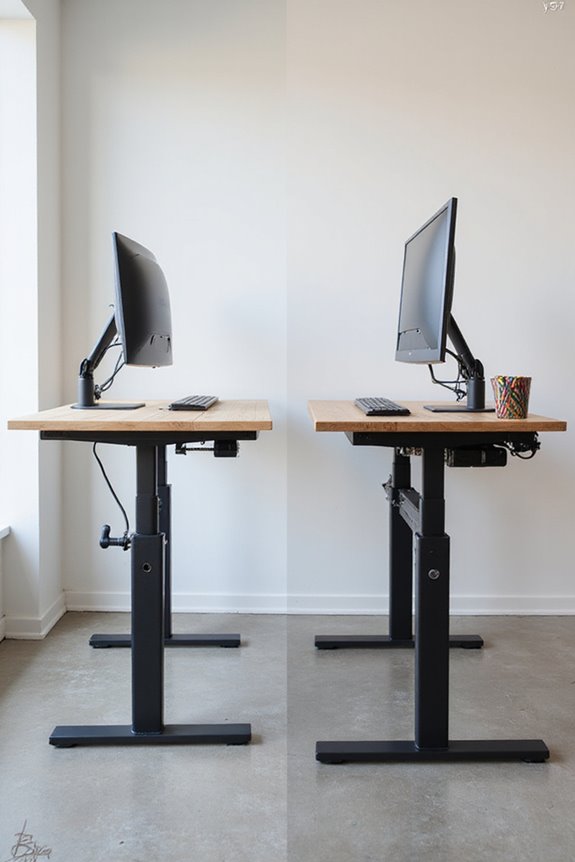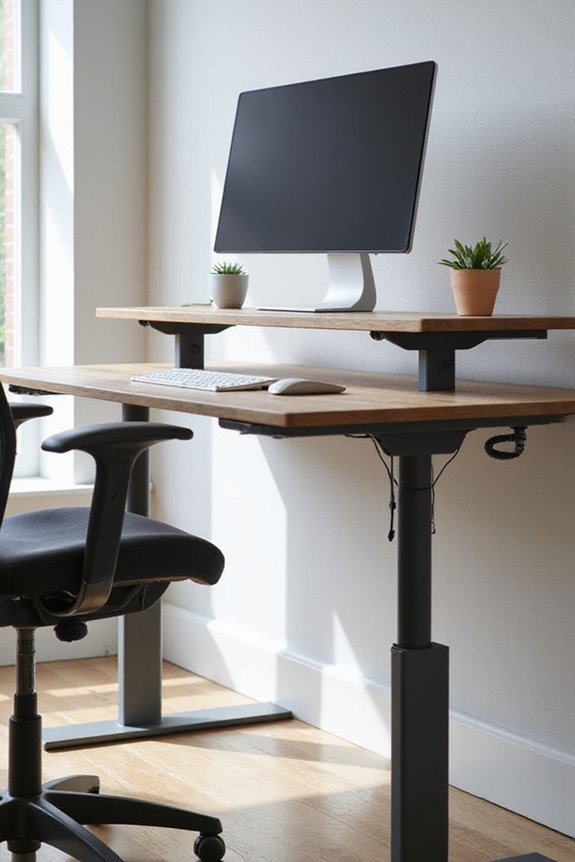Using a standing desk can improve your physical health by enhancing musculoskeletal comfort, reducing fatigue, and promoting better circulation. It also supports cardiovascular health by reducing sedentary time, although it’s important to incorporate movement throughout the day. Standing desks can aid cognitive function and mood, fostering engagement and clarity at work. However, balancing standing and sitting is essential to avoid circulatory risks. Understanding these benefits can guide you towards creating a healthier workspace.
Key Takeaways
- Standing desks improve musculoskeletal health by reducing discomfort in the neck, shoulders, and lower back.
- Alternating between sitting and standing enhances circulation and reduces fatigue, promoting better energy levels.
- Using a standing desk can help improve cognitive performance and boost mood throughout the workday.
- Standing more can contribute to burning extra calories, though regular exercise is crucial for weight management.
- A balanced approach of sitting, standing, and movement is essential to mitigate potential circulatory risks.
Physical Health Benefits
While many of us spend long hours sitting at a desk, shifting to a standing desk can lead to considerable physical health benefits. One major advantage is the improvement in musculoskeletal health. I’ve noticed that using a standing desk considerably reduces discomfort in my neck, shoulders, and lower back. Alternating between sitting and standing helps distribute physical stress evenly, preventing chronic pain.
Additionally, I’ve experienced noticeable fatigue reduction. Standing promotes better circulation and energy expenditure, leaving me feeling less tired by the end of the workday. This shift not only refreshes my physical energy but also enhances my cognitive alertness. Overall, adopting a standing desk has positively impacted my daily productivity and well-being, making it a worthwhile change. Furthermore, using an anti-fatigue mat can further enhance comfort during prolonged standing, reducing strain on the legs and back.
Cardiovascular Improvements

Adopting a standing desk can influence not just musculoskeletal health but also cardiovascular well-being. While standing more reduces sedentary time, it doesn’t automatically improve cardiovascular health. Research indicates that prolonged standing can lead to circulatory issues like varicose veins and deep vein thrombosis. It’s vital to remember that standing posture alone isn’t enough; incorporating movement throughout the day is essential. Alternating between sitting and standing, along with taking walking breaks, can help maintain healthy blood circulation. Fundamentally, if I want to enhance my cardiovascular health while using a standing desk, I need to combine it with regular physical activity rather than relying on static standing alone. This approach will yield the best cardiovascular benefits.
Metabolic and Weight Effects
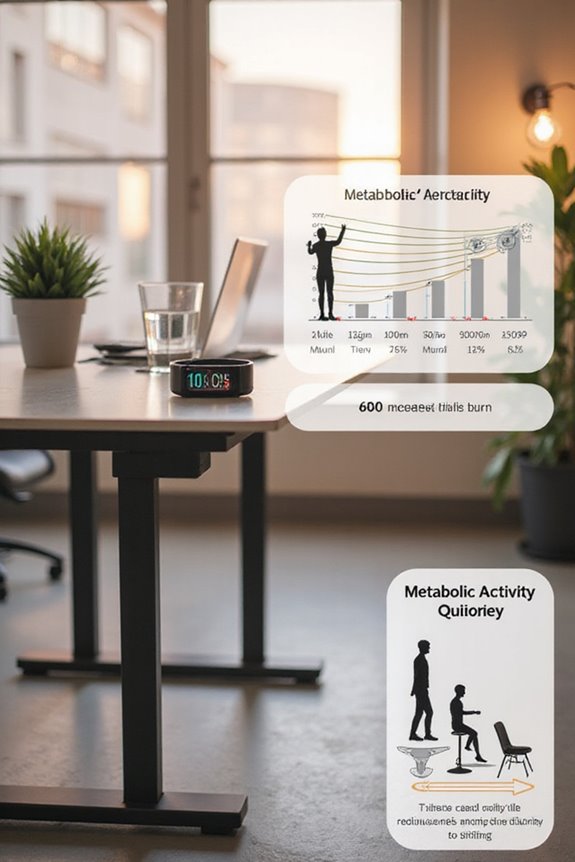
To enhance my metabolic health and manage weight effectively, I need to understand the implications of using a standing desk. While standing at my desk can burn about 24 extra calories every three hours, this amount is minimal compared to other activities. I’ve learned that standing desks may help reduce insulin resistance, potentially improving my metabolic health over time. However, they won’t greatly aid in weight loss or prevent weight gain, as studies show no substantial changes in BMI with their use. To truly support my weight management, I should combine standing with regular exercise, like walking during breaks. Balancing standing and sitting is essential to avoid potential circulatory risks while maximizing the metabolic benefits of my standing desk.
Cognitive Performance and Mood

As I explore the benefits of standing desks, it’s clear that they can positively impact cognitive performance and mood. Research shows that using active workstations, like standing desks, enhances cognitive engagement, leading to improved reasoning scores and better executive function over time. I’ve found that standing doesn’t hinder work performance, regardless of task difficulty. Additionally, increased movement at work is linked to mood enhancement, creating a more positive workplace environment. Users report no negative impact on their perception of work or mood. By reducing sedentary behavior, standing desks foster mental clarity and cognitive performance, making them a valuable addition to any workspace. Overall, the combination of movement and engagement promotes both cognitive and emotional well-being.
Ergonomics and Workplace Wellness
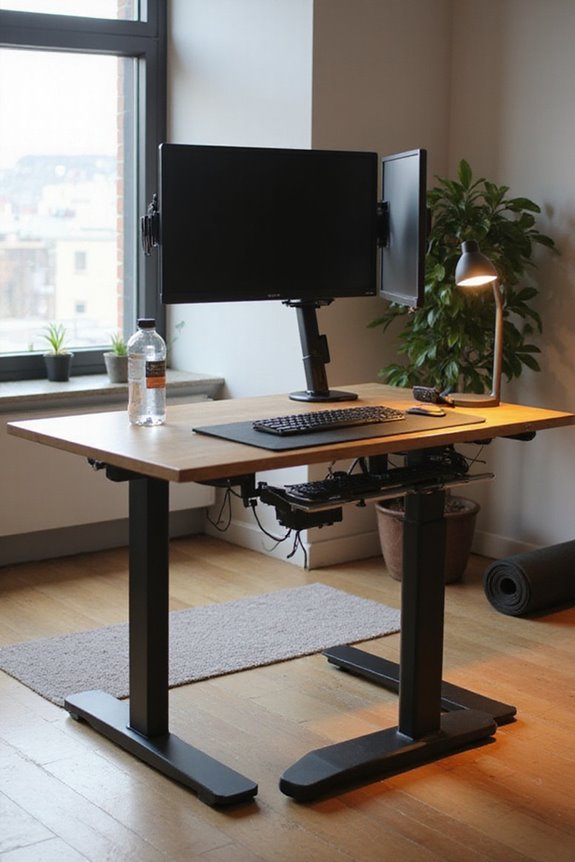
Ergonomics plays an essential role in workplace wellness, particularly when it comes to the integration of standing desks. The ergonomic design of these desks promotes better posture and reduces back and neck pain, allowing me to work comfortably. By enabling easy height adjustments, they cater to individual needs, helping to minimize strain on muscles and joints.
Moreover, standing desks encourage a more active workplace culture. They support increased movement throughout the day, which helps combat fatigue and enhance focus. This shift in our work environment contributes to long-term health benefits, such as improved circulation and reduced risks of chronic diseases. Ultimately, adopting standing desks can lead to a healthier, more engaged workforce, positively impacting overall workplace wellness. Additionally, features like integrated cable management ensure a tidy workspace, further enhancing the ergonomic benefits of these desks.
Risks and Considerations

While standing desks offer numerous benefits, it is essential to recognize the potential risks associated with prolonged use. One significant concern is the increased risk of circulatory issues, including varicose veins and deep vein thrombosis. Standing for extended periods can exacerbate these conditions, as each additional half-hour beyond two hours of standing heightens circulatory risks.
Moreover, research indicates that simply standing more doesn’t reduce the risk of cardiovascular diseases, like coronary heart disease and stroke. It’s important to balance standing with movement and physical activity throughout the day. To maintain overall health, I recommend alternating between sitting and standing, ensuring you don’t exceed safe standing durations, and remaining active to mitigate these risks effectively.
Personalization for Maximum Benefits
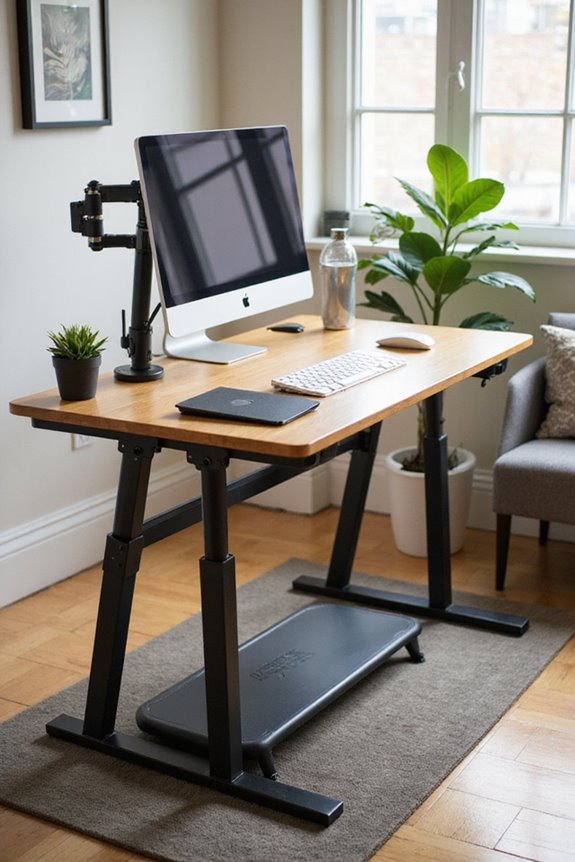
A well-fitted standing desk can transform your workspace, enhancing both comfort and productivity. By customizing your workspace to align with your user preferences, you can maximize the health benefits of standing desks. Height-adjustable desks allow you to tailor the height to your body dimensions, ensuring ideal ergonomics and reducing discomfort. This personalization also fosters better posture, which can alleviate strain on your muscles and joints.
Additionally, a custom workspace encourages you to alternate between sitting and standing, combating sedentary behavior. Regular movement increases your energy levels and cognitive function, leading to improved productivity. Ultimately, investing time in personalizing your standing desk setup can considerably contribute to your overall well-being and work efficiency. A standing desk with adjustable height promotes better posture and supports various user heights, accommodating a diverse workforce.
Frequently Asked Questions
Can Standing Desks Help With Productivity in Remote Work Environments?
I’ve found that standing desks can really help with productivity in remote work. By encouraging movement, they provide a productivity boost and make long hours more comfortable, keeping me focused and engaged throughout the day.
Are There Specific Standing Desk Exercises to Enhance Benefits?
I find that incorporating standing desk stretches, like calf raises and leg swings, really helps with posture improvement. It keeps me energized and reduces stiffness, making my workday much more enjoyable and productive.
How Do I Choose the Right Standing Desk Height?
When I choose my desk height, I focus on ergonomic adjustment, ensuring my elbows bend at 90 degrees. It’s essential for comfort and productivity, so I regularly adjust it to suit my needs throughout the day.
Can Standing Desks Benefit People With Specific Health Conditions?
Standing desks can support those with specific health conditions, especially chronic pain and cardiovascular health. I’ve noticed that alternating between sitting and standing really helps alleviate discomfort and boosts my overall well-being.
What Accessories Can Improve Comfort While Using a Standing Desk?
When I use a standing desk, I find anti-fatigue mats and ergonomic chairs make a huge difference in comfort. They help reduce strain and keep me feeling energized throughout the day. Comfort really matters!

